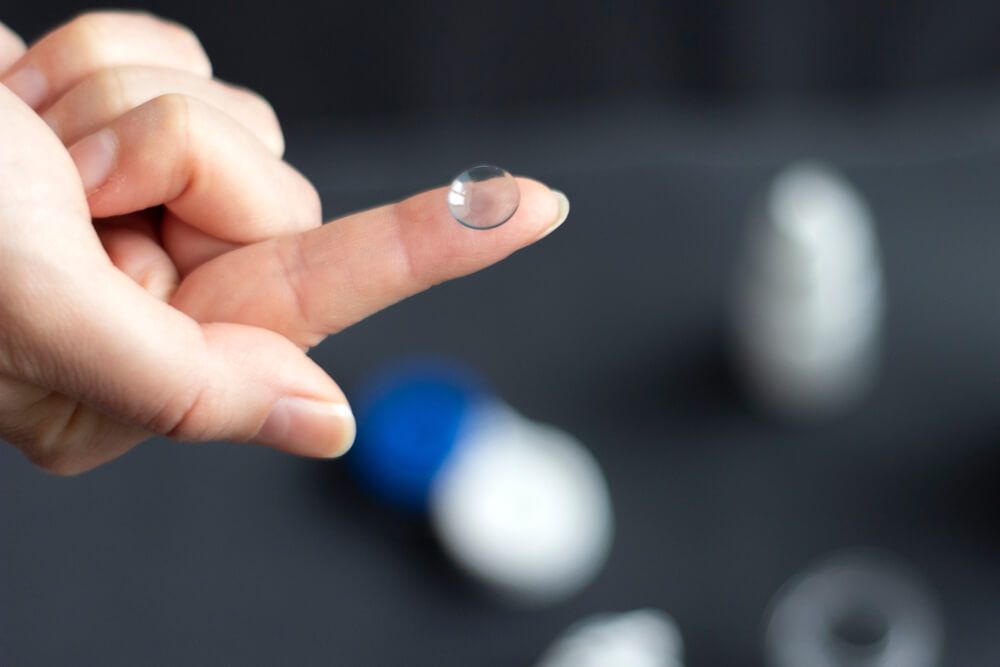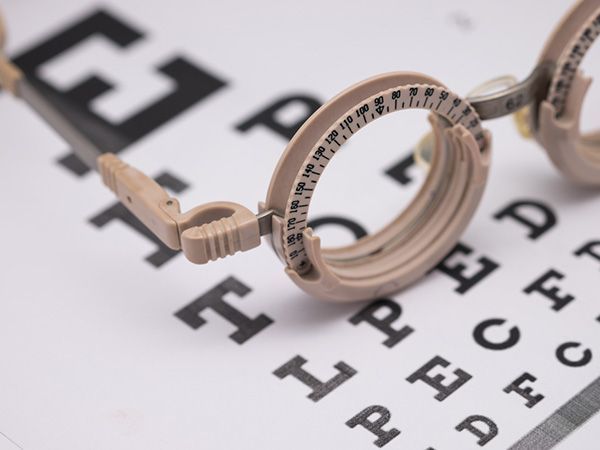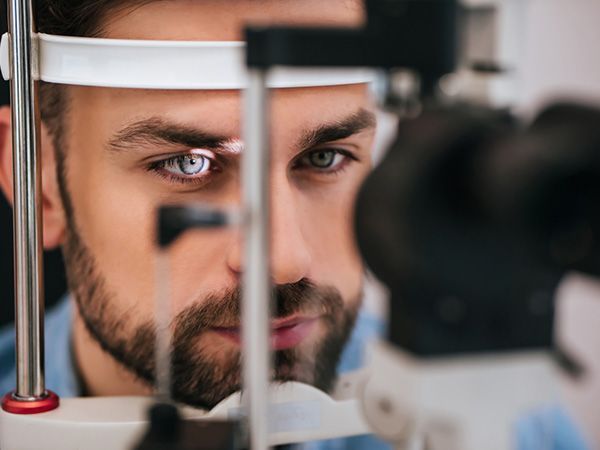
If you’ve been diagnosed with cataracts, you may wonder if cataract surgery is right around the corner. Not to worry. There are many preventive steps you can take to slow the progression of cataracts and preserve your vision. That doesn’t mean you won’t eventually need surgery, but you can at least delay the need for quite a while.
Protect Your Eyes from the Sun
The National Eye Institute recommends protecting your eyes from the sun's harmful ultraviolet (UV) and high-energy visible (HEV) rays by always wearing good quality sunglasses while outdoors. Look for sunglasses that block 100 percent of UV rays and absorb most HEV rays with large lenses or a close-fitting wraparound style. Remember that the peak hours for sun exposure are between 10 am and 3 pm or 11 am and 4 pm during daylight savings time and that the sun’s rays are strong enough to pass through clouds, so you need your sunglasses every day.
Avoid Steroid Eye Drops
Steroid eye drops are routinely prescribed to treat dry eyes or an arthritic flare-up in the eyes. Unfortunately, they can also speed up the progression of cataracts. Talk to your Optometrist or Ophthalmologist about how you can manage both conditions without inadvertently making your cataracts worse – and hastening the need for surgery.
Check Your Medications
There are over 300 commonly prescribed medications with side effects that may impact cataract progression. Since your primary care physician may not have access to your eye doctor’s medical records, be sure to ask your doctor if your current medications will affect your cataracts. If you must stay on the medication, it’s even more important to avoid sunlight during peak hours and to wear sunglasses.

Many patients come to us every day struggling to get through their daily lives with their current choice of vision correction. Some have eyeglasses that do not sit properly on their face or feel that their peripheral vision is hindered by the frames. While contact users may find the lenses uncomfortable or have them fall out at inconvenient times. For these patients, we are pleased to offer orthokeratology, or Ortho-K, a revolutionary way to help you see clearly throughout the day without having to wear glasses or contacts and without having to get laser eye surgery.
What is Ortho-K?
Generations ago, eye doctors knew that the tissue in the eye was soft and somewhat malleable. This knowledge caused them to wonder if they could push the eye back into the proper shape, would an individual be able to see clearly even if they were not wearing their prescription lenses. With the development of gas permeable contact lenses, a few eye doctors began to notice that their patient’s prescriptions did not change as rapidly as previously noted and that they appeared to be able to see correctly even when they were not wearing their contacts.
From these early discoveries, the world of Ortho-K was born. Ortho-K is a special treatment to help patients see clearly even when they are not wearing a prescription lens. Instead, a special gas permeable contact lens is placed into the eye each night before bed and the lens gently pushes the eye into the proper shape while you sleep. In the morning, you can remove the lenses and still see clearly throughout the day. Some patients can even see clearly for up to three days after wearing them for just one night!
Who Should Consider Ortho-K?
There are a number of issues that our patients can have with prescription lenses. If you have one of the following conditions or concerns, call our office today to schedule an appointment.
Allergies to the materials in contact lenses
Dry eye that is made worse by wearing prescription lenses
Dirt or other debris that gets under contact lenses
You play sports and do not want to worry about glasses or contacts
The ability to wake up at night and see clearly
A general dislike of glasses or contacts
How Long Does It Take?
Once you receive your custom Ortho-K contact lenses, it will take anywhere from one to four weeks to fully see all the benefits to your vision that they will provide. However, some of our patients find that their vision has improved after only wearing their lenses for a single night! During the first few days, you may also still need to wear prescription lenses to see clearly enough to drive or get through your normal day, but that is generally quickly resolved. Also, some patients experience some mild discomfort for the first few nights, but as your eyes adjust over a few days, you should no longer be bothered by the feel of your lenses. Is the Procedure Safe? Orthokeratology was approved by the Food and Drug Administration (FDA) in 2002. The procedure is considered safe, effective, and reversible. However, there are some side effects associated with Ortho-K. Most of these side effects are a result of improper cleaning of the lenses that can lead to a minor infection. These infections are usually remedied fairly quickly with the use of antibiotic eyedrops. Overview If you are sick and tired of wearing contact lenses or glasses every single day and would like an alternative way to correct your vision, consider trying Ortho-K. If you would like more information on Ortho-K, please call our offices today and see how we can improve your everyday life.

Myopia is a very common issue throughout the world. Approximately 1/3 of the population in the United States have the condition and over 90% of several East Asian countries suffer from myopia. While myopia may seem like such a common condition that it shouldn’t be cause for concern, it is actually associated with several very serious conditions that can threaten one’s ability to see.
What is Myopia
Myopia, more commonly known as nearsightedness, is a condition where individuals are able to see objects that are close to them but may have difficulty distinguishing things at a distance, such as road signs or leaves on a tree. These individuals often squint at objects that are further away to try and help bring them into focus.
Currently, there is no known cure for myopia and recent studies suggest that the more advanced your myopia gets, the more serious the effects can be on your vision. This has led eye professionals to look for ways to slow the progression of myopia in children and young adults as the eyes typically change more rapidly during this time and slowing down myopia progression during these years has a huge payoff.
Types of Myopia Control
There are a few different treatments for myopia that have proven to be effective in a number of studies. Of course, to ensure you find the most effective choice for you, be sure to visit with your eye doctor so they can review your case and recommend the best options for you.
Ortho-K | Ortho-K or Orthokeratology is one practice being used to slow down the progression of myopia. Ortho-K utilizes a special rigid gas-permeable contact lens that is placed into the eyes just before you go to bed. This hard lens helps to gently hold your eye in the proper shape throughout the night. Then when you wake up in the morning and remove the lenses, your eye continues to maintain that shape. This means that people who are nearsighted can see clearly throughout the day, even without wearing contact lenses or glasses. This approach is often preferred for athletes or other active individuals.
Atropine Eye Drops | One of the thoughts about the progression of myopia, is that it is associated with eye strain. The additional stresses that are placed on the eye when straining push the eye further out of its proper shape. Atropine eye drops are specifically designed to help stop the eye from straining and help the muscles relax. Atropine is similar to the eye drops that are used when you get your eyes dilated but lasts throughout the entire day rather than just a few hours. Atropine dilates the pupil of the eye and prevents them from closing too tightly and limiting your vision. This treatment has been shown to be especially effective in slowing the progression of myopia in children.
Multifocal Eyeglasses and Contact Lenses | These specialty contact lenses are designed to help reduce strain on the eyes. They have shown great success at slowing the progression of myopia over a three-year period when compared with individuals who wore a standard prescription lens.
Overview
If you notice that your child is having a difficult time seeing objects that are far away, contact us today to schedule an appointment. Many parents notice changes in their children with their behavior or grades at school, their ability to play sports, or that they may even be pulling back from playing with friends. Treating myopia as quickly as possible can help to reduce your child’s chances of developing a serious eye condition that can threaten their ability to see the world around them. Call today and schedule an appointment to see how we can help your child.

Amblyopia, also known as a “lazy eye”, is described as a reduced vision in one eye compared to the other. There are some rare forms of amblyopia that involve both eyes. Amblyopia is the most common cause of partial or total blindness in one eye in children.
The term lazy eye is misleading because the eye is not actually lazy. In fact, it is a developmental problem in the nerve connecting the eye to the brain, affecting the brain’s ability to use both eyes together. It is not a problem in the eye itself, but in the brain which actively ignores the visual input from the misaligned eye, leading to amblyopia in that eye.
In addition to poor visual acuity, people with amblyopia are more prone to having difficulties with depth perception, eye movements related to reading, and visual decision making while driving.
What Are The Causes of Amblyopia?
Amblyopia develops in childhood due to:
Significant differences in the prescription (refractive) status between the two eyes due to nearsightedness, farsightedness or astigmatism;
Constantly misaligned eyes or crossed eyes (strabismus);
An obstruction of vision in early childhood i.e. cataract, ptosis (droopy eyelid)
It is important to note that, because amblyopia is typically a problem of infant vision development, symptoms of the condition can be difficult to detect. Symptoms may include noticeably favoring one eye over the other, an eye turn (either upward-downward outward or inward) or a tendency to bump into objects on one side.
The best way to identify children who are at risk for or already have amblyopia is by performing comprehensive eye examinations.
How Is Amblyopia Treated?
Amblyopia can be treatable at any age, although the earlier the problem is found and treated, the more successful the outcomes tend to be.

LASIK is the number one elective surgical procedure today, and more than a million Americans have had the procedure since its inception. The main reason for its popularity is the many benefits that it offers, including minimizing or in some cases even eliminating the need for the patient to use eyeglasses or contact lenses after the procedure.
Let’s take a look at why LASIK is taking the ocular world by storm.
Better vision
Clearly, the biggest reason for choosing LASIK is improved vision. While some patients have relatively mild problems with their eyesight, others experience major disturbances in their vision that makes functioning day to day almost impossible without the use of visual aids. LASIK can dramatically improve the quality of your vision, reducing the need to wear visual aids, or in some cases, completely eliminating it.
A good investment
Eyesight is also notoriously inconsistent, with the majority of people finding that their vision marginally improves or deteriorates with each visit to their optician. When this happens, it is necessary for the optician to recommend a different prescription, and this means expense as the patient finds themselves purchasing new eyeglasses or contacts to reflect their new visual requirements.
Although there is no guarantee that you will be able to completely prescription-free after LASIK, most patients find that eyesight is so improved that any changes to their prescription are much less frequent.
Eyeglasses and contacts are known for being fiddly and fragile, and the need for maintenance and replacements are a common complaint. However, with less need for such devices, the cost of caring for them is also reduced.
A short, painless procedure
LASIK surgery can be performed in one, very short procedure. You should expect to spend around 30 minutes in the surgery suite, but the actual time it takes can be as little as 10 minutes – for both eyes! The remainder of the time will be spent preparing you and ensuring you are comfortable afterward. The entire process is carried out after anesthetic drops have been placed into your eyes, so you can rest assured you will feel absolutely no pain throughout. However, if you are particularly anxious about the process, it may be possible to be given a sedative to help you relax.

We all want to look our best and in the last decade, we have seen a significant increase in the number of people seeking cosmetic services in order to enhance their appearance. With our eyes being our most distinguishing feature, we want to make the most of them. Thankfully there is now a range of cosmetic services that can help to rejuvenate our eyes and the area around them to keep them fresh, young and wrinkle-free.
Let’s take a look at some of the services on offer.
Pigment removal
The brown pigment spots that appear on the face are often referred to as age spots and are a result of sun exposure. With age, the repeated exposure to UV rays causes melanin, a compound that is responsible for pigmentation and protecting the skin begins to clump together to form an area of hyperpigmentation. Whilst they aren’t any cause for concern, many people feel that they look unsightly. Luckily, there are a number of different treatments that you can get to remove them including topical creams, laser therapy, and chemical peels.
If you are suffering from darker pigmentation then we strongly recommend that you make an appointment with a qualified dermatologist who will recommend the best course of treatment for you, based on your specific needs.

If you are one of the thousands of people considering LASIK laser eye surgery, then you will probably be gathering as much information as possible about the treatment. By this point, you are probably aware of the benefits that LASIK offers, such as a reduced or eliminated need for glasses or contact lenses and greater convenience in your day to day life. However, for many patients, despite the advantages of LASIK, the thought of surgery on their eyes is still a cause of anxiety and fear. One of the best ways to alleviate this concern is to find out more about what the procedure entails.
Your consultation
Before you can be approved for any form of laser vision correction, including LASIK, you will need to attend a consultation appointment with your surgeon. During the consultation, he will perform an examination of your eyes and use your medical and ocular history to determine if you are a good candidate for the procedure. He will also speak to you about the expected outcome from your surgery, making you aware that while LASIK will dramatically improve your eyesight, there is no guarantee that you will not need to wear glasses in some situations, such as while driving in the dark.
How LASIK Works
LASIK uses a cool, ultraviolet beam of light to reshape the patient’s cornea. Doing so will more accurately focus the light that enters the eye on to the retina, thus improving the patient’s vision.
The way in which the cornea needs to be reshaped will depend on the visual needs of the patient. For example, a patient who is far-sighted will need their cornea reshaping to be steeper to experience better eyesight. Alternatively, a patient who is near-sighted will require their cornea to be flattened in order to improve their vision. LASIK can also smooth an irregular cornea into a more standard shape, meaning that the procedure can also be used to correct astigmatism.
The LASIK procedure
The LASIK procedure is very fast and straightforward. Although you will probably be in the surgical suite for around half an hour, the actual process only takes a couple of minutes per eye. The rest of the time will be spent preparing and ensuring that
you are comfortable. Anesthetic eye drops are given to patients before their procedure so that the entire process is pain-free. If you are particularly anxious, it may also be possible for you to be slightly sedated – this should be discussed with your doctor at your consultation appointment.
Once you are in position, we will use a femtosecond laser to cut a thin, circular flap into the outer cornea. This can then be pulled back to reveal the underlying corneal tissue, known as the stroma so that it can be reshaped using the laser. The exact path that the laser needs to take, known as the topography, will have been pre-programmed ahead of the procedure and can be followed with complete precision and accuracy.
Once the reshaping is complete, the flap is replaced back over the eye and the surgery is complete. There is no need for sutures or bandages as the cornea will start to heal immediately and without any medical intervention.

If you already rely on wearing glasses or contact lenses to be able to see clearly, you may be frustrated with the effect that they have on your life. Regular vision tests, finding glasses to suit your face shape, having to remember to take eyeglasses with you wherever you go, prescription sunglasses, fiddly contact lenses… the list of inconveniences associated with conventional ocular solutions is extensive.
LASIK is a modern, minimally-invasive procedure that can substantially reduce or eliminate your need to use eyeglasses or contact lenses, allowing you to enjoy life without limitations or inconvenience. The popularity and success of LASIK laser eye surgery have helped to make it the number one elective surgery across the globe.
Candidacy for LASIK
LASIK has an extremely high success rate. According to the American Society of Cataract and Refractive Surgery, 96% of patients achieve 20/20 vision or better. However, it’s high success rate doesn’t make LASIK automatically the right solution for everyone.
Candidacy for LASIK is assessed by our doctors on a case by case basis so that you be certain that whatever treatment is recommended for you, it will give you the very best opportunity to improve your vision. During your consultation, our doctors will perform a thorough examination of your eyes and vision, ask you about your general health and talk you through both the procedure and aftercare.
The general guidelines for LASIK candidacy state that patients must:
be at least 18 years of age
have had stable vision with no prescription changes for a minimum of 12 months
have a current prescription for eyeglasses or contact lenses that falls between specified parameters (Our doctors will be aware of what these parameters are)
have no significant medical or eye-related problems such as glaucoma, macular degeneration or diabetic retinopathy
have no history of corneal disease
not be pregnant or nursing at the time of the procedure

Our eyes are one of our most defining facial features, yet many of us are unhappy with them for one major reason – our lashes. Lashes are not only a practical feature but a cosmetic one. Unfortunately, we have not all been blessed with long, curly, dark and luscious lashes that frame our face. In fact, many of us feel that our lashes are a little lackluster, missing fullness and definition. Thankfully, there is now a solution – Latisse.
Latisse is a prescription treatment for hypotrichosis (shorter, thinner or otherwise inadequate eyelashes) that can help your lashes to grow longer, darker, and fuller than before and is the only product of its kind to be FDA-approved.
How does Latisse work?
Latisse works by increasing the length of the anagen phase of your eyelash hair cycle, which is the growth phase. This means that your eyelashes grow for longer periods of time, giving them the chance to thicken and lengthen.
Why do I need a prescription for Latisse?
Latisse is only available by prescription to ensure that it is only used by people who suffer from hypotrichosis and so that your doctor can monitor your treatment.

Macular degeneration, commonly referred to as age-related macular degeneration (AMD), is the single largest cause of sight loss in the developed world and affects more than 10 million Americans. It usually affects people over the age of 60, but has been known to affect those who are younger. It is a painless condition that usually affects both eyes with the loss being experienced in the central vision. It does not affect the peripheral vision, meaning that it does not cause total blindness.
What is the macula?
The macula is the most sensitive part of the retina and is responsible for our central vision and what allows us to see fine details with clarity.
Varieties of AMD
Wet AMD
Wet AMD is one variety of the condition in which abnormal blood vessels grow into the macula, leaking blood or fluid which then causes scarring and a rapid loss of central vision. Wet AMD can develop suddenly and rapid referral to a specialist is essential as it can be treated if caught quickly.
Dry AMD
Dry AMD is the most common variety of age-related macular degeneration and is a gradual deterioration of the retina as the cells die off over time and are not regenerated. Up to 15% of people with dry AMD go on to develop wet AMD, and so any sudden changes in your vision should be followed up with your ophthalmologist as soon as possible.








